
Lavender fields in Provence.
Famous characters and mythical years, captured in a bottle. The lyrical, olfactory tribute to history is at the heart of Histoires de Parfums, a French niche perfume house founded in 2000 by Gérald Ghislain. As the Histoires de Parfums website explains, each of the early fragrances was entitled just with a date in history, the year in which a legendary figure was born. In the case of “1725,” it was Giacomo Girolamo Casanova who is best known for being a libertine, lover and seducer of women, though he was also much, much more. For example, did you know that some scholars believe Casanova helped write some of the lyrics to Mozart’s Don Giovanni opera, that he translated the mighty Iliad, got into a heated debate over religion with the brilliant Voltaire, or that he was a highly respected political advisor?
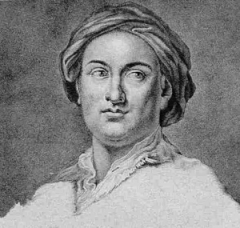
Giovanni Casanova via Wikimedia.
I bring up these other attributes because some may think that a perfume dedicated to Casanova would be a mighty oriental, intended to seduce with opulent, sensuous notes — and they would be mistaken. Histoires de Parfums has taken a very different tack with 1725, creating an aromatic fougère with gourmand qualities. The company’s full description for 1725, along with its notes, is as follows:
Venice, the riparian city of love. In that year of 1725 was born the man whose name would symbolize seduction: Giacomo Girolamo Casanova.
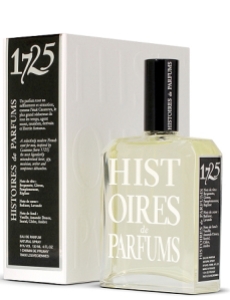 « What is love then? An illness to which man is prone to any age », claimed the one who was one after the other abbot, officer, scholar, writer, banker, con artist, magician, infantryman, spy, diplomat, but always claiming his Venetian origins. For every Casanova, here is an eau de parfum inviting intense pleasure, an amber fern mixing fine wooded tunes and touches of lemony freshness, sublimed by the elegance of lavender. Warmed with heady spices and colored by sweet fruits.
« What is love then? An illness to which man is prone to any age », claimed the one who was one after the other abbot, officer, scholar, writer, banker, con artist, magician, infantryman, spy, diplomat, but always claiming his Venetian origins. For every Casanova, here is an eau de parfum inviting intense pleasure, an amber fern mixing fine wooded tunes and touches of lemony freshness, sublimed by the elegance of lavender. Warmed with heady spices and colored by sweet fruits.
Originality: vanilla lavender combination.
Top Note: Bergamot, Citrus, Grapefruit, Licorice
Heart Note: Lavender, Star Anise
Base Note: Vanilla, Almond, Sandalwood, Cedar, Amber
1725 Casanova doesn’t evoke either the man or sybaritic Venice to me. Instead, I’m taken to modern Provence, perhaps the Luberon before Peter Mayle’s wonderful Year in Provence books made it less of a magical secret. I see vast fields of lavender infused by the aroma of a thousand patisserie shops at its base. They are filled with vanillic almond croissants, pate d’amande, aniseed galettes, and frothy vanilla drinks. Surrounding the lavender fields is a long avenue of cedar trees that create a bridge to the orchards of yellow lemons and zesty yellow grapefruits. The corridor of woody trees is occasionally tinged by smoke but, more frequently, by that wafting scent of vanilla from the patisseries at the bottom of the hill. To me, that is the perfume in a nutshell.

Source: Worldfortravel.com
1725 Casanova opens on my skin with aromatic herbs and citruses with underlying spices and a quietly muted leather note. The lemon is zesty, fresh, very crisp and similar to the juice in unsweetened lemonade. The grapefruit is similarly yellow and tart. Intermingled with both notes is lavender that feels smooth, not bitter or pungent. A little bit of spicy anise flickers at the edges and, within seconds, is joined by some very exuberant almond atop a light vanilla base.
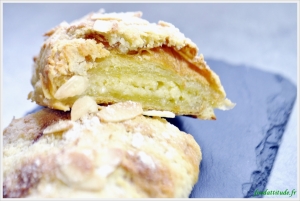
Croissants aux amandes via foodattitude.fr http://www.foodattitude.fr/article-croissants-aux-amandes-113855705.html
The almond and vanilla notes are in sharp contrast to the lavender and citrus. The former evokes a French breakfast pastry; the latter, the herbaceous hills of Provence where fields of lavender meet orchards of citrus fruits. The sweetness of the almond-vanilla accord prevents Casanova’s opening from feeling like a primarily masculine fragrance with its typical fougère combination of herbaceous, aromatic citruses and lavender.
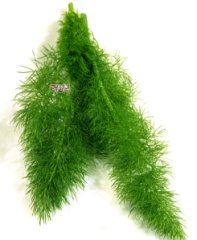
Fennel fronds.
Still, the perfume seems almost split into two until, about five minutes in, a bridge is formed between the two camps, thanks to the advent of the cedar note. It’s just barely peppered but, instead, creamy and backed by lightly spiced anise. The latter doesn’t feel like black licorice candy or even dried star anise; instead, it feels more like the fresh green fronds of an anise vegetable or, as Americans call it, fennel. It’s a beautifully delicate, subtle note, especially when mixed with the creamy wood accord, and the two together help to bridge the divide between the other competing groups. But I still found 1725 to be a bit jangly and discordant at the beginning.
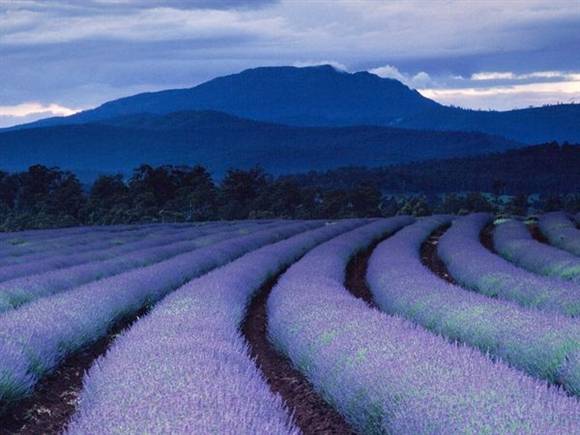
Source: Usafilm.info
Twenty minutes in, 1725 Casanova turns into a smoky cedar and lavender perfume, with the tiniest dash of citrus and anise notes– all over a vanilla-almond base. The cedar note is beautiful, especially with the lavender — a note that some of you know that I absolutely despise in large quantities. Here, however, it is well done, adding just a subtle aromatic herbaceous quality to the peppered woods while also feeling airily creamy and sweetened. It helps that it’s subtle, creating an overall gauzy haze over the notes, but never smelling like those revoltingly concentrated sachets of dried lavender that were as ubiquitous in the South of France (especially Cannes) as the air you breathed. (If you lived in Cannes, which is right next to Grasse, you were so inundated by lavender sachets, oils, perfumes, creams, bath products, and lavender of every possible formulation, you ended up almost being traumatized. Few places in the South of France are so deluged and bombarded with the note as Cannes which is only about 18 minutes away from the world’s center of perfumery and lavender. So, by the time we escaped to Monte-Carlo, it was too late; I was scarred for life with a searing, deeply rooted, life-long lavender phobia.)
To my surprise, it is actually the vanilla note in 1725 Casanova with which I have greater difficulty. Infused by almond like that in pate d’amande, there is something extremely sickly about it. And, despite its generally light airiness, it feels both cloying and somewhat synthetic. Thankfully, however, about an hour into Casanova’s development, it softens and becomes significantly better. No longer cloying and quite so jangly (for lack of a better term), it mellows out into a much more harmonious note, blending in well with both the marzipan-like almond and the lavender.

Source: Epicurus.com
Starting at the 90 minute mark and for the rest of Casanova’s development, the perfume becomes a well-modulated, balanced, almondy-vanilla fragrance that has almost a heliotrope-like quality and which is infused with light, sweetened lavender — all atop a base of smoky wood notes touched fleetingly with softly spiced, herbal anise. It’s not dessert-like or gourmand; 1725 has too much lavender, light smoke and dry woods for that, but it’s also not a truly masculine fougère, either.
1725 remains that way until its very end, never changing in any dramatic way but merely softening until, finally, it is nothing more than a soft vanilla with a touch of lavender over an abstract, woody base tinged with the smallest whisper of smoke. Its sillage was generally moderate at the start, never projecting loudly; this is far too refined a fragrance for volume. Instead, it creates a very small, soft cloud within which the perfume is quite detectable. 1725 Casanova became a skin scent around the fourth hour, remaining there for a number more hours until it finally faded away shortly after the 8 hour mark.
It is surprisingly pretty — even to one who despises lavender. I wore 1725 Casanova to dinner with my parents and, to my surprise, it was a huge hit with the two biggest perfume snobs I know. I don’t know who is more difficult to please: my mother or my father. Almost everything I make them smell is greeted with disdainful silence and a faintly curled lip. Occasionally, there is a single raised eyebrow, a faint shudder, and a horrified comment on the state of modern perfumery. (“Why would anyone want to smell like food??!!) Out of perhaps 50 recent fragrances, I can only remember four or five perfumes receiving enthusiastic approval. Yet, both of them really liked 1725. Frankly, I couldn’t quite believe it. They did disagree somewhat on how powerful a perfume it was: my father thought it was strong; my mother scoffed. And, to my amusement, my mother refused to believe that 1725 Casanova was technically classified as a masculine fragrance. Simply refused. (“That’s a woman’s perfume,” to which my father responded, “Who cares? It smells really good.”)
I agree with both of them. 1725 Casanova is about as unisex as it comes. It’s also an extremely wearable, easy fragrance that would fit a variety of casual situations. I myself wouldn’t go near lavender on any frequent basis (let alone spend actual money on it), but if I think 1725 Casanova is pretty, then those with less violent lavender antipathies may love it.
On Fragrantica, opinions seem split. Half the posters think 1725 Casanova is a charming, lovely, wearable, and even elegantly sophisticated scent; the other half think it’s not hugely interesting, especially as compared to some other Histoires de Parfums perfumes. (The aggressively masculine leather scent, 1740 known as Marquis de Sade, is often mentioned.) Men seem to be more critical, while the few women who have reviewed 1725 seem to like it for themselves. And I think both facts really sum up the perfume: it’s not a very masculine scent, let alone a complicated one. As such, it will fall short with men who prefer the more unusual, and much more obviously masculine, fragrances from the same brand. Yet, there are enough admirers who find it utterly “charming” and timeless to show that it really depends on whether you want something classically elegant or something a little more rakishly adventurous.
One such admirer is the famous perfume critic, Luca Turin, who categorizes 1725 Casanova as an “Anisic Lavender” and gave it a Four Star review in Perfumes: The A-Z Guide:
Anisic notes are hard to handle in perfumery: they are sweetly happy on their own (few things smell better than star anise in a bag) but usually stand out in ensemble playing as a pan flute would in a string quartet. This clever fragrance associates two such notes, licorice and star anise, to a lavender-citrus structure and somehow clips the whole thing together with a touch of heliotropin and cedarwood. Top and heart are wonderfully melodious, and the drydown comes close enough to L’Heure Bleue to feel its gravitational pull, but then escapes again. Very good.
My experience wasn’t identical to his, especially as I never detected a strongly black licorice note and the anise one was much more like soft fennel than truly spicy, almost bitterish, woody, very pungent, dried star anise. That said, I can see why he would compare 1725’s drydown to L’Heure Bleue, and I do think it’s a good fragrance — even with the lavender.
As a final note, a huge number of people on Fragrantica seem to think 1725 Casanova resembles MDCI‘s Invasion Barbare. I haven’t tried or reviewed the latter, so I can’t comment, but 33 people voted on the similarity on each perfume’s page. A few noted subtle differences, such as one commentator who said that Casanova was similar but “with the violet removed and the notes toned down and refined.” All I can tell you is that 1725 is significantly cheaper than the MDCI fragrance: a 2 oz/60 ml bottle of Casanova costs $125, while the exact same size for Invasion Barbare costs $250.
In short, if you like anise and lavender, then I’d definitely recommend giving 1725 a sniff.
DETAILS:
Cost, Availability, Decant Sets & Samples: 1725 Casanova is an Eau de Parfum that comes in two sizes: 2.0 oz/60 ml for $125 or €145; or 4 oz/120 ml for $205. (Further decant or mini-sized options are below). Both full bottle sizes are available on the Histoires de Parfums website, which also has a fantastic sample program (6 samples of your choice) whose $20 price goes towards the purchase of a large 4 oz. bottle. Further details are available here as to how the process works. Shipping is free for all orders anywhere in the world for purchases over $130; below that, there is a $10 shipping fee. In the U.S., 1725 Casanova is available from Luckyscent in both sizes, along with samples. BeautyHabit has not only the 2 bottles but also a 14 ml decant for $36. The perfume is also found on Amazon in the smaller $125 size. The Perfume Shoppe (which has a Canadian division) sells 14 ml decants of 1725 for $36. Another option may be from Beauty Cafe which sells a 3 Bottle Nomad Kit of any 3 HdP fragrances in 14 ml bottles for $96. Outside the U.S.: In the UK, you can find it at Roullier White for GBP £125 for the smaller 2 oz/60 ml bottle. For the rest of Europe, you can find it at First in Fragrance for €145 for the 2 oz bottle. In Australia, you can find it on sale at City Perfume for AUD$179 for 2.0/60 ml oz or at the full AUD$190 price at Peony Melbourne. For all other countries, Histoires de Parfums vast Store Locator lists retailers from South Africa to the Netherlands, Sweden and Kuwait. Samples: You can find samples at a number of the retailers linked to above. Surrender to Chance has a variety of different options and sizes for 1725 Casanova, from samples to decants. Samples begin at $4.99 for a 1 ml vial.










